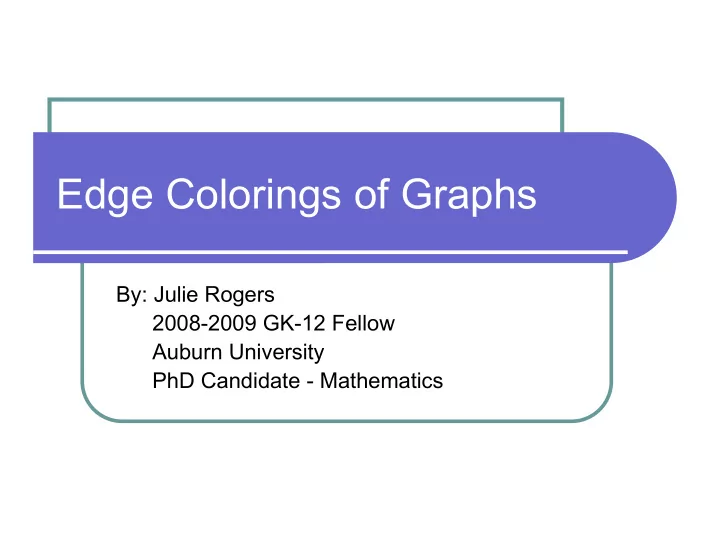

Edge Colorings of Graphs By: Julie Rogers 2008�2009 GK�12 Fellow Auburn University PhD Candidate � Mathematics
Outline � Definitions � Related Theorems � Real World Application � Proposed Labs � Curriculum Connection
Definitions � A graph, G, is � V(G), a nonempty finite set of vertices � E(G), a finite set of edges � A relation that assigns to each edge a pair of not necessarily different vertices called the ends (endpoints) of the edge � Note: A simple graph is one where each edge has distinct endpoints, ie, no loops or multiple edges
Examples Cycle Bipartite Complete Graph, but not simple Petersen
Definitions � Adjacent: a pair of vertices are connected by an edge Nonadjacent Adjacent vertices vertices
Definitions � Incident: vertex and edge connected 1 2 a f b 6 e 3 c d 5 4
Definitions � Degree of a vertex: the number of edges the vertex is incident with 2 3 1 4 7 5 6
Definitions � Max degree: the largest vertex degree in the graph (denoted by <) 2 3 1 4 7 5 6
Definitions � An edge coloring of a graph is an assignment of labels (colors) to the edges 2 3 1 4 7 5 6
Definitions � A proper edge coloring of a graph is an edge coloring such that edges sharing an endpoint have distinct colors 2 3 1 4 7 5 6
Definitions � A proper edge coloring of a graph is an edge coloring such that edges sharing an endpoint have distinct colors 2 3 1 4 7 5 6
Definitions � The chromatic index of G, X’(G), is the fewest number of colors needed for a proper edge coloring 2 3 1 4 7 5 6
Definitions � The chromatic index of G, X’(G), is the fewest number of colors needed for a proper edge coloring 2 3 1 4 7 5 6
Definitions � The chromatic index of G, X’(G), is the fewest number of colors needed for a proper edge coloring 2 3 1 4 7 5 6
Definitions � The chromatic index of G, X’(G), is the fewest number of colors needed for a proper edge coloring 2 3 1 4 7 5 6
Definitions � The chromatic index of G, X’(G), is the fewest number of colors needed for a proper edge coloring 2 3 1 4 7 5 6
Definitions � The chromatic index of G, X’(G), is the fewest number of colors needed for a proper edge coloring 2 3 1 4 7 5 6
Question � What do we know about the chromatic index and the degrees of a vertex? 2 3 1 4 7 5 6
Answer � < ≤ X’(G) � The chromatic index is greater than or equal to the max degree
Related Theorems � If G is bipartite, then X’(G) = <(G) (Konig) � If G is a simple graph, then <(G) ≤ X’(G) ≤ <(G) + 1 (Vizing) � For cycles, X’(G) = 2 if the cycle is even X’(G) = 3 if the cycle is odd
Real World Application � Suppose you want to schedule weekly games for a youth football league � Let there be 10 teams and each team plays the other 9 teams once; 9 weeks of games � How can we schedule games making sure no team plays another team twice and no two teams are supposed to play against the same team during the same weekend?
Real World Application � Solution � Use a complete graph on 10 vertices to schedule the games in the league � The 10 teams will be the vertices and the edges represent the games between the two teams it is incident with � Find a proper edge coloring using 9 colors ( <(G) )
Real World Application � Solution � Each color will represent one week of games (9 weeks of games); ie, an edge means that the two endpoints will play each other during the specified “color” week of play � Can you create the 9 week schedule?
� �� � �� � � � � � � � �
Proposed Labs � Guide the students through a proof of one of the related theorems, use leading questions to allow the students to discover the missing parts of the proof � Let the students actually find proper colorings in various graphs, also to include different cycles and bipartite graphs so they can hopefully recognize and apply the related theorems
Proposed Labs � From one of Mrs. Lishak’s workbooks: � Take a map of the United States. Color each state such that no two states that share a border are the same color and find the chromatic number � Essentially, this is just a proper coloring of a graph � States are the vertices and an edge exists if the two states share a border – Then apply a proper coloring and the problem is solved
Curriculum Connection � Use inductive and deductive reasoning (AL COS 9, 17) � Use methods of proof to justify theorems (AL COS 9, AHSGE II�1, II�2) � Analyze information (AL COS 9) � Real life applications related to … geometric shapes (AL COS 5)
Curriculum Connection � Geometry Strand, 9�12 Emphasize proof by induction by having students communicate with each other and justify theorems and methods of solving problems (AL COS 2, 8) � Algebra Strand, 9�12 Solving word problems involving real life situations (AL COS 8)
THE END THANK YOU! ☺ QUESTIONS?
Recommend
More recommend